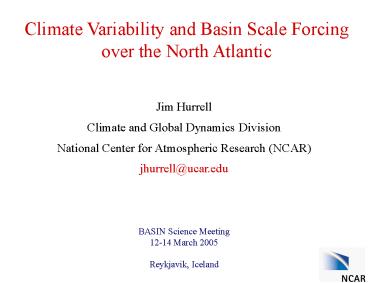Climate Variability and Basin Scale Forcing - PowerPoint PPT Presentation
Title:
Climate Variability and Basin Scale Forcing
Description:
Climate Variability and Basin Scale Forcing over the North Atlantic Jim Hurrell Climate and Global Dynamics Division National Center for Atmospheric Research (NCAR) – PowerPoint PPT presentation
Number of Views:49
Avg rating:3.0/5.0
Title: Climate Variability and Basin Scale Forcing
1
Climate Variability and Basin Scale Forcing over
the North Atlantic
Jim Hurrell Climate and Global Dynamics
Division National Center for Atmospheric
Research (NCAR) jhurrell_at_ucar.edu
BASIN Science Meeting 12-14 March
2005 Reykjavik, Iceland
2
Climate Phenomena in the Atlantic
North Atlantic Oscillation (NAO)
Tropical Atlantic Variability (TAV)
Meridional Overturning Circulation (MOC)
- MOC, TAV and NAO interact, but in ways that are
not well understood
- Understanding Atlantic climate
variability/change requires a global view
3
The Mean State and Stationary Waves (DJF)
4
Change in Winter Surface Temperature since 1980
Cold
Warm
Human activities are superimposed on the
background noise of natural variability
5
Change in Winter Sea Level Pressure since 1980
(hPa)
Dec-Mar
Pressure Falls
Pressure Rises
6
The North Atlantic Oscillation
Spatial Structure and Seasonal Variability
DJF
MAM
SON
JJA
7
Alternative Definition Cluster Analysis (Winter
Only)
NAO- 29
NAO 20
Scand 21
Ridge 30
8
Time History of Occurrence
NAO
NAO-
Scand
Ridge
9
The North Atlantic Oscillation Winter
Spatial Structure
Dec-Mar 39 SLP (hPa)
Stronger Westerlies
hPa
10
Winter Surface Temperature
Change since 1980
11
NAO Influence on Winter Precipitation
(Positive Index Phase)
12
Ocean Response to NAO Variability
13
Ocean Response to NAO Variability
Leading patterns of North Atlantic climate
variability
Sea Surface Temperature
500 hPa Geopotential Height
r 0.72
14
Ocean Response to NAO Variability
SST
Winter Index (1864-2002)
Stronger Westerlies
Weaker Westerlies
15
Multi-decadal SST Variability
- Oceanic response to atmospheric decadal
variability?
16
Multi-decadal SST Variability
- Oceanic response to atmospheric decadal
variability?
- What is the role of non-local dynamical oceanic
processes?
17
Ocean Response to NAO Variability
Changes in Water Masses
18
Ocean Response to NAO Variability
Circulation Changes
Oceanic NAO analogue Eastward Transport Index
Curry and McCartney (2001)
19
Sea Ice Response to NAO Variability
-
Deser et al. (2000)
20
What Climate Processes Govern NAO Variability?
Simulated (Dec-Mar)
Random and Unpredictable Variations
21
What Climate Processes Govern NAO Variability?
- 200 years of CCM3 without variations
- in external forcings
EOF1 SLP (Dec-Mar)
- Basic structure time scale arises
- from internal nonlinear atmospheric
- dynamics
Simulated NAO Index
Random and Unpredictable Variations
r (1yr) -0.07
r (1yr) -0.06
A role for external forcing?
22
The Role of Ocean Forcing
JFM 500 hPa Height Trend (1950-1999) m
Rises
Falls
23
Reproducibility Individual Runs
Trend of JFM 500 hPa NAO Index (1950-1999)
GOGA (multi-model)
-200 -100
0 100 200
(m)
24
JFM Trend in Tropical SST (1950-1999)
Cold
Warm
25
JFM Response to Indo-W. Pacific SST Trend
26
(No Transcript)
27
(No Transcript)
28
Change in Tropical SST (1950-1999)
29
Concerning observed winter North Atlantic climate
change
- NAO is most prominent and recurrent pattern of
- atmospheric variability, driving upper-ocean
and - sea ice variations
- Nonlinear approaches reveal spatial asymmetries
- between the two NAO phases
- Basic structure and time evolution results from
- internal, nonlinear atmospheric dynamics
- Climate noise paradigm does not explain behavior
- in recent decades
- Model experiments suggest North Atlantic climate
- change has been driven, at least in part, by
warming - tropical SSTs, with the Indo-Pacific region
key
30
Cautionary notes
- NAO explains only a fraction of the total
variability
- No evidence for periodic behavior
- Nonlinear approaches give a different view of
the - dynamic signature of interannual North
Atlantic - climate variability
31
Future Change
?
Numerous modeling studies indicate two Atlantic
phenomena that might change
NAO and MOC
32
Future Change
NAO
- Most climate models simulate an increasing
trend, - with pressure decreases over the far North
Atlantic - and pressure increases in middle latitudes
- Details vary considerably from model-to-model,
and - the simulated trends are smaller than observed
33
Future Change
NAO
Simulated (7 models)
Gillett et al. 2003
Concerning the discrepancy with observations
- Inability to capture mechanisms of by which
stratospheric flow - anomalies affect the tropospheric evolution
- Details of the simulated SST field are important
34
Future Change
MOC
- Most, but not all, climate models project some
- weakening due to warming and freshening
35
Future Change
MOC
- Most, but not all, climate models project some
- weakening due to warming and freshening
- Nature of changes and mechanisms vary
considerably - from model-to-model
- Ongoing CMIP subproject to investigate model
- differences
- Effect of weakening is to moderate regional
warming
36
(No Transcript)































